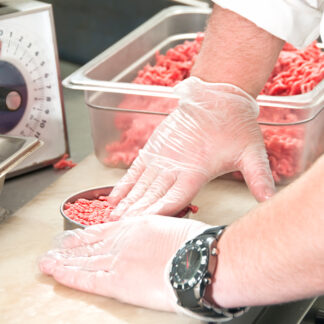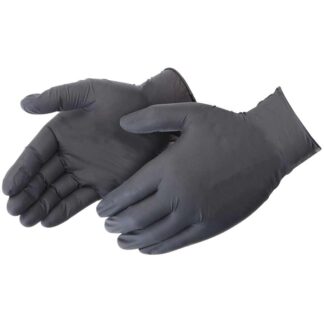Disposable Gloves
Liberty Safety provides a comprehensive range of disposable gloves, offering various levels of protection. Choose from a selection of protective disposable gloves from the DuraSkin® Industrial Grade and BioSkin® Examination Grade brands. Individual glove styles and materials are chosen specifically to suit the ideal needs of your work environment.
Liberty Safety provides a comprehensive range of disposable gloves, offering various levels of protection.
Choose from a selection of protective disposable gloves from the DuraSkin® Industrial Grade and BioSkin® Examination Grade brands. Individual glove styles and materials are chosen specifically to suit the ideal needs of your work environment.
FAQ
Disposable gloves are made from a variety of materials, primarily latex, nitrile, polychloroprene, vinyl, and polyethylene. Each material offers distinct benefits depending on the use and application. By examining the attributes of each material type, you can determine which one is best suited for your needs
| Material | Description |
| Nitrile | Nitrile gloves are manufactured using synthetic polymers and are more puncture-resistant than natural rubber. They are a perfect choice for protection from a variety of chemicals. Easily donned, this product is the ideal choice for your disposable needs when latex allergens are a concern. Industrial grade nitrile gloves are made from component materials that meet food contact and handling requirements. Our medical-grade nitrile gloves comply with FDA regulations. |
| Latex
|
Latex (Rubber)gloves are the industry’s choice when optimal barrier protection is a requirement. Latex is also considered to provide the greatest fit of any disposable glove. These gloves are available in powdered and powder-free, medical, and industrial grades. Industrial grade latex gloves are made from component materials that meet food contact and handling requirements. Our medical-grade latex gloves comply with FDA regulations. |
| Vinyl | Vinyl gloves s derived from synthetic PVC resins offer a cost-effective alternative to latex. They are ideal for food preparation, light-duty cleaning, and general maintenance. Like latex and nitrile, vinyl gloves are in powdered and powder-free versions. Industrial grade vinyl gloves are made from component materials that meet food contact and handling requirements. Our medical-grade vinyl gloves comply with FDA regulations. |
| Polychloroprene | Polychloroprene gloves are a proprietary formulation of completely synthetic polymers closely related to neoprene. This unique compound combines the barrier performance of a synthetic glove with the superior comfort found only in natural latex. Polychloroprene gloves are ideal against abrasive and corrosive chemicals, grease, contaminated soil and composites, and sharp edges from plastic and other materials. Due to their extra comfort and exceptional tactile sensitivity, these gloves are popular for food handling. Industrial grade polychloroprene gloves are made from component materials that meet food contact and handling requirements |
| Polyethylene | Polyethylene gloves are a cost-effective solution for creating a barrier between hands and products. They are ambidextrous, have an embossed grip, and are mainly used in food service environments and parts handling. |
Disposable gloves are essential across nearly every industry. From healthcare to food service, these gloves ensure compliance with FDA and USDA regulations. Our extensive selection caters to a wide range of applications and budgets, reflecting our expertise and deep knowledge in providing the right protective solutions for any need.

According to the Occupational Safety and Health Administration (OSHA), disposable gloves should never be reused. Microscopic tears can form after use, increasing the risk of exposure to germs.
According to OSHA, disposable gloves should be changed frequently, with the frequency depending on their use. In medical settings, gloves need to be changed often, based on facility policies. In food preparation, one or two sets may suffice for an entire work period, but this also varies by workplace policy.
As experts in protective solutions, we recommend replacing gloves immediately if you notice holes, punctures, or any damage. New gloves are also necessary after handling chemicals or contaminants and when starting a new task. Generally, OSHA advises changing disposable gloves every four hours to ensure optimal safety and hygiene.
Judging the comfort and fit of disposable gloves is crucial for optimal performance and safety. It’s essential any disposable glove “fits like a second skin” for the best result. If they are too large, gloves can slip off or twist during use. Conversely, they may tear and restrict movement if they are too small. Choose gloves that fit well and are specifically designed for the task at hand to ensure the best results.







